Elekit TU8600 Amplifier Kit
Review by Noam Bronstein
As music pours out of Elekit’s new amp through my speakers, I’m smiling, and remembering that some things are much more than the sum of their parts. Some things just work, and those who have heard the mighty 300B tube perform its magic through full-range drivers understand this. That’s why you’re reading this review, naturally.
For you guys who need to scroll down to the conclusion, I’ll save you the trouble. The Elekit TU8600 is a superb amp, and an excellent value. If you can build it, and have reasonably sensitive speakers, I can’t think of a better new amp to buy in 2017. Order it before they’re gone. Seriously. I loved this amp’s predecessor, the 8300R; and the new 8600 is an even better amp. In literally every conceivable way. It’s off the charts, for me.
What is it?
I won’t go into a backgrounder on Elekit, since we’ve talked about them, and already reviewed four of their amplifiers on this site. This is a kit. It comes in a big box with everything you need to build it, minus a few basic tools. Soldering iron is a must, of course. You don’t need a bunch of electronics knowledge, but you’ll need some patience, and a little hand-eye coordination helps. If you struggle with light bulbs or fuses, you might want to ask a friend to build it for you, or to help. Most people can do it themselves.
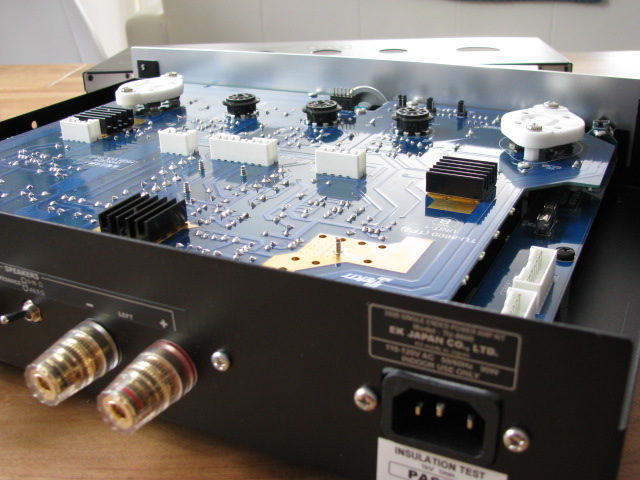
Tube kits are nothing new, they’re a fun and valid way to be involved in the audio hobby. What’s different here is the quality of the finished product. You finish an Elekit build, and you’ve just put a world class hi-fi product on your shelf. It’s dead quiet. There’s no transformer hum, no hiss, nothing. Like the previous TU8300, this amp is quieter than some solid-state amps – and in fact, residual noise is claimed to be as low as 1/10th that of the TU8300(!). Operation includes a soft-start circuit to save your tube life. There are no annoying thunks from your speakers when you use the power switch. Everything is really well done here. And best of all, it makes outstanding music. And you built it yourself! Sure, you didn’t design it. But you assembled and tested it, which in itself brings a great amount of satisfaction to the equipment purchase experience.
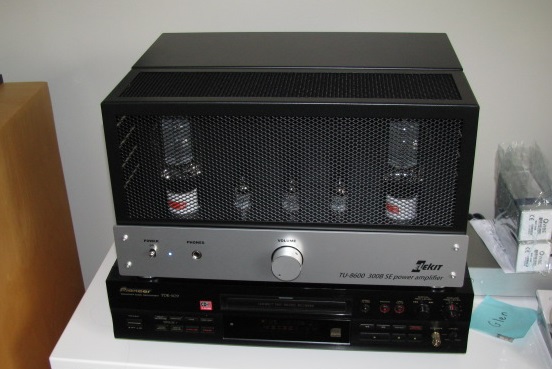 Size wise, the TU8600 isn’t diminutive, but it’s certainly not a big amp, either. Being about an inch less wide than typical 17-inch components gives it a slim look – but naturally, using 300B power tubes means it’s also a lot taller than most of that gear. Overall, I’d call it mid-sized – and that definitely adds to the element of surprise at how big this amp sounds. It’s appearance is a bit plain, but the understated look has grown on me. I like the simplicity, and the absence of too many ugly screw heads. It has a classier, more finished look than any other kits I’ve seen. I like that the cage is secure enough without screwing it in, that I can easily remove it or leave it on.
Size wise, the TU8600 isn’t diminutive, but it’s certainly not a big amp, either. Being about an inch less wide than typical 17-inch components gives it a slim look – but naturally, using 300B power tubes means it’s also a lot taller than most of that gear. Overall, I’d call it mid-sized – and that definitely adds to the element of surprise at how big this amp sounds. It’s appearance is a bit plain, but the understated look has grown on me. I like the simplicity, and the absence of too many ugly screw heads. It has a classier, more finished look than any other kits I’ve seen. I like that the cage is secure enough without screwing it in, that I can easily remove it or leave it on.
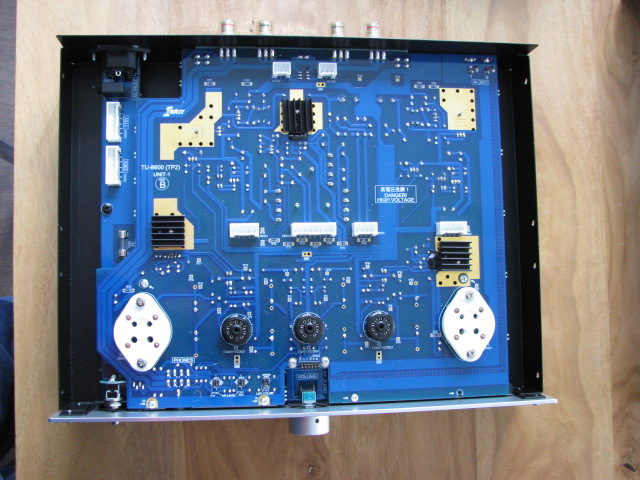
Some of the technical highlights of this design include: Cathode Feedback (CFB) utilizing a third OPT winding (allowing NFB use to be minimized); Active Automatic Bias circuit; a two-stage warmup cycle to save your valuable tubes; and a redesigned voltage gain circuit (2 x 12AU7 + 1 x 12ax7) that allows for 200V peak to peak without wave clipping, i.e. driving the 300B’s pretty close to their full potential. This is a key difference over the TU8300; the designer (Mr.Yoshitsugu Fujita) found that with CNFB being applied, it requires higher input and the amp has to be driven with bigger amplitude than what was achieved with the previous single-stage of the TU8300 (which was 2 x 12at7). Hence the 3-tube input/gain stage. Like the 8300, the new model continues to utilize a Shottky barrier diode for rectification. This method tends to deliver a tighter, faster, punchier performance than tube rectification, with the tradeoff being a less tube-like presentation. It’s a tradeoff that I personally prefer, not everyone does. Also new here – a headphone amp circuit. And it’s a good one, too! For a commercial blurb highlighting these technical features and specs, you can have a look at the Elekit product sheet.
Pricing: in North America, where VK Music is the exclusive distributor, the basic amp kit will be priced at $1185 (USD), without tubes. Add around $300 for tubes and we are in the $1500 range. There are tube sets available from VK Music, if you want them to ship with your order, as well as resistor and capacitor upgrades. They are all worth considering. Most important, VK is offering custom Lundahl (LL2770) output transformers, at an upgrade cost of $525 per pair. Part 2 of this review will include my impressions on the Lundahl upgrade. But I’ll say outright now, that if you can afford it, do order the Lundahls while they’re still in supply. They take this amp to another level. The cost isn’t insignificant, but the value for what you get is astonishing.
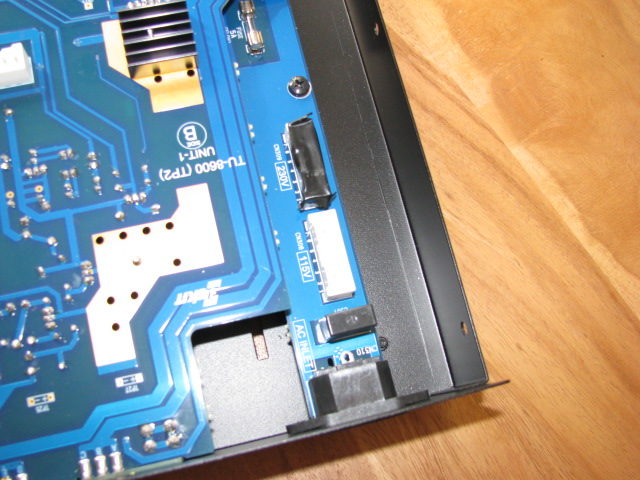
For some, the lingering question remains – will I be able to build it? What I’ll say is, although this isn’t a kit intended for novices, it is laid out in a way that really sets you up for success. I’ve included some photos and screen shots – look these over, they should give you confidence. Yes, there are a lot of small details to follow, but if you take it step by step, checking off what you’ve done and making notes of anything you aren’t sure of, you’ll be able to go back and review it (along with your solder joints), and, if you paid attention, the amp will work the first time you plug it in. I think Elekit have made the build process as straightforward as it can possibly be, while still creating a true world-class performing amp. These kits are nothing if not precise; Victor Kung told me that after selling more than 1400 Elekit kits, his parts completeness scoring is still at 100%. Every one of them was correct. After building the TU8500, that doesn’t surprise me.
Is it The Best?
My expectations were high, but this amp has really amazed me. It is the best 300B amp that I’ve spent any appreciable time with. It startles me again and again with its sense of power and drive. Low-power DHT amps aren’t often described as sounding effortless, but the Elekit really does sound effortless. Like an amp with loads of reserve power. Yes – it is sweet. Sort of. The 8600’s ‘sweetness’ is unlike any 300B I’ve heard, though. It isn’t at all syrupy smooth, or “lush”, or dark, or soft. It IS organic – the music ‘breathes’ through this amplifier, instruments sound like themselves, voices sound like the people singing, and the amp never sounds constrained. Nor does it ever sound dry or analytical – and yet, it does have some of the desired qualities I associate with (good) solid state amps. Especially: a sense of authority and ease, a lot of dynamic capability (at least with sensitive speakers), a lot of punch, for lack of a more refined word. And a lot of top-end sparkle. So then: not a particularly romantic sounding amp, no obvious colourations. It’s not rolled off at the top. You just have the overwhelming sense that you’re listening to a great amp. A musical amp. Satisfyingly musical. But also ‘accurate’, for lack of a better word. It does something special with the 300B tube, somehow it’s appropriate, but if you were blindfolded, you probably wouldn’t guess you were listening to a 300B. And yet, it has taken my appreciation of the 300B to a new level.
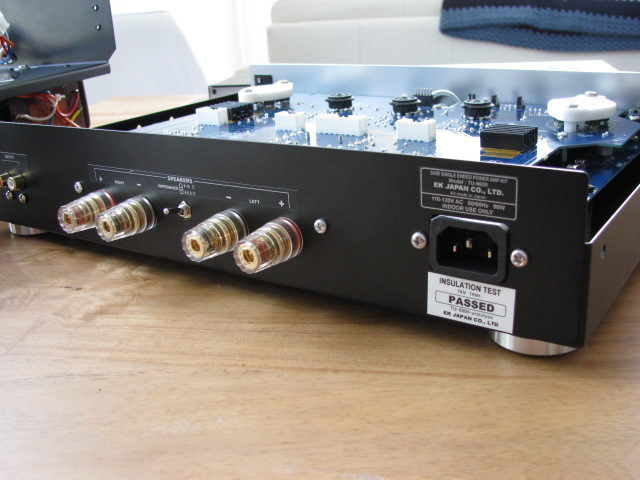
Just a caveat to those comments, my speakers are Lowther backhorns rated at ~96-97dB sensitivity, and a very easy impedance load. The Elekit will drive speakers of considerably lower sensitivity, and Part 2 of this review will include a “road tour” to hear the amp with other speakers, in other rooms (friends). My comments so far are based on listening with my Lowthers, and comparing the amp with other amps I’ve been using of late (Pass ACA, Elekit TU879S). *I did also connect some speakers that are in the 88-90dB zone, and the Elekit seems to drive them just fine, but the calibre of said speaker was not good enough to make any judgments with.
Listening to the wonderful Bill Evans’ Some Other Time – The Lost Sessions from The Black Forest, I heard a great sense of speed, and impeccable timing. Not the first things you expect to notice from a 300B SE amp, right? I’ve honestly never heard a 300B that sounded this ‘fast’. Piano attack and decay were superb: the tone but also the sense of the piano being a percussion instrument. Cymbal hits were impressive, delicate and amazingly realistic. Upright bass was some of the best I’ve heard on my Lowthers. I could (and did) listen to this 2-CD set for hours on end.
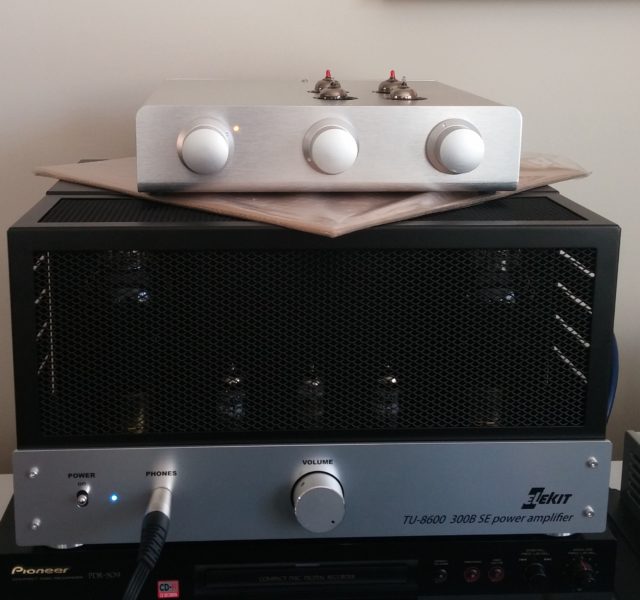 Listening with an active preamp: I did some comparisons back and forth between the Elekit fed directly, and fed through the Aikido line stage (I used another identical interconnect for these tests). When using the Aikido, I pinned the Elekit’s volume pot wide open, to eliminate it from the circuit. My Aikido has a very similar Alps pot, and to be honest, using the line stage had no discernible effect on the sound of the Elekit. I went back and forth several times and really, they sounded essentially the same.
Listening with an active preamp: I did some comparisons back and forth between the Elekit fed directly, and fed through the Aikido line stage (I used another identical interconnect for these tests). When using the Aikido, I pinned the Elekit’s volume pot wide open, to eliminate it from the circuit. My Aikido has a very similar Alps pot, and to be honest, using the line stage had no discernible effect on the sound of the Elekit. I went back and forth several times and really, they sounded essentially the same.
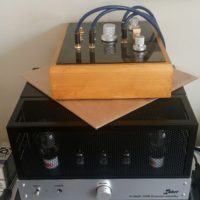 Listening with a passive attenuator: This is where it got interesting. My passive is a switch/attenuator built from the John Broskie/Tubecad/Glass Audio kit. It allows switching between three inputs, and some attenuation – the steps are incremented such that the degree of attenuation control isn’t as good, but that’s because only one attenuation resistor is engaged at any setting (a good thing). And indeed, I heard an improvement using this passive: the sound was more transparent, a little ‘cleaner’ overall. Bass was a little tighter, too. It wasn’t a stunning difference, but it was noticeable. I liked it (consistently) better with the passive attenuator. This leads me to conclude, not that I have a great passive preamp, but that the stock Alps pot that comes with the TU8600 can be improved on; it’s an easy change to make, and the results are going to be evident to the listener. VK Music may already offer an attenuator upgrade; they’ve done this with other amps in the past. It’s worth asking.
Listening with a passive attenuator: This is where it got interesting. My passive is a switch/attenuator built from the John Broskie/Tubecad/Glass Audio kit. It allows switching between three inputs, and some attenuation – the steps are incremented such that the degree of attenuation control isn’t as good, but that’s because only one attenuation resistor is engaged at any setting (a good thing). And indeed, I heard an improvement using this passive: the sound was more transparent, a little ‘cleaner’ overall. Bass was a little tighter, too. It wasn’t a stunning difference, but it was noticeable. I liked it (consistently) better with the passive attenuator. This leads me to conclude, not that I have a great passive preamp, but that the stock Alps pot that comes with the TU8600 can be improved on; it’s an easy change to make, and the results are going to be evident to the listener. VK Music may already offer an attenuator upgrade; they’ve done this with other amps in the past. It’s worth asking.
Tube rolling with Psvane tubes
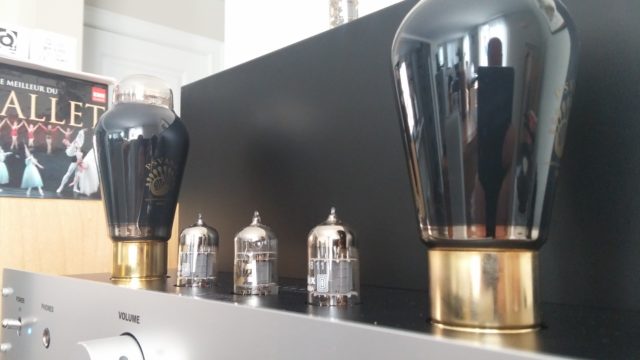
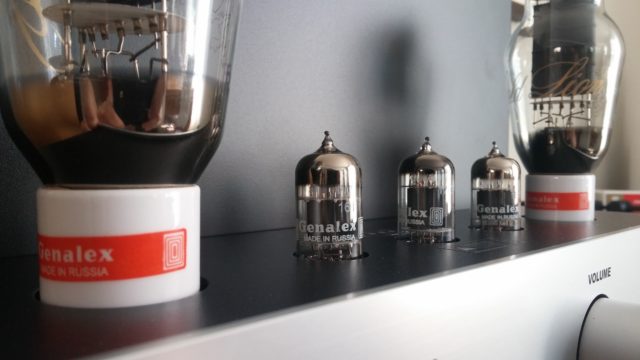 Briefly, I had a chance to compare the Genelex Gold Lion reissues that VK supplied (these are some of Russia’s best tubes) with the premium Psvane’s, which are some of China’s best. Only the 300B and 12AX7 were swapped. This was a casual, non-exhaustive comparison, but I did several back and forths, using Enya’s CD Watermark, and Kenny Burell’s LP Midnight Blue. My first impression was that the Psvane’s play quite a bit louder. Adjusting the gain, my impression was that the Psvane tubes are slightly more romantic sounding – they sound a little warmer and smoother. By comparison, the Genelex Gold Lions sounded faster, and a little more articulate. The Psvane tubes sounded more “tubey”, in the classic sense. Their bass was a touch fatter. Some days you want fast, some days fat is nice. Overall, I still prefer the Genelex by a small margin, especially where value is concerned. To be clear – the Psvane are also great tubes, I enjoy them and they do compliment the Elekit very nicely. I just don’t necessarily see them (for me) being worth the cost premium over the Gold Lions, which were my favourites from the 2015 shootout. Your mileage may vary, and if you find the Elekit to sound a touch too lean (perhaps due to it being ss-rectified), I can see how one could utilize tubes like the Psvane to flavour the sound a little differently. Either way sounds great, but one may please you more, or suit your music better. Tube rolling is fun, so by all means, have some fun.
Briefly, I had a chance to compare the Genelex Gold Lion reissues that VK supplied (these are some of Russia’s best tubes) with the premium Psvane’s, which are some of China’s best. Only the 300B and 12AX7 were swapped. This was a casual, non-exhaustive comparison, but I did several back and forths, using Enya’s CD Watermark, and Kenny Burell’s LP Midnight Blue. My first impression was that the Psvane’s play quite a bit louder. Adjusting the gain, my impression was that the Psvane tubes are slightly more romantic sounding – they sound a little warmer and smoother. By comparison, the Genelex Gold Lions sounded faster, and a little more articulate. The Psvane tubes sounded more “tubey”, in the classic sense. Their bass was a touch fatter. Some days you want fast, some days fat is nice. Overall, I still prefer the Genelex by a small margin, especially where value is concerned. To be clear – the Psvane are also great tubes, I enjoy them and they do compliment the Elekit very nicely. I just don’t necessarily see them (for me) being worth the cost premium over the Gold Lions, which were my favourites from the 2015 shootout. Your mileage may vary, and if you find the Elekit to sound a touch too lean (perhaps due to it being ss-rectified), I can see how one could utilize tubes like the Psvane to flavour the sound a little differently. Either way sounds great, but one may please you more, or suit your music better. Tube rolling is fun, so by all means, have some fun.
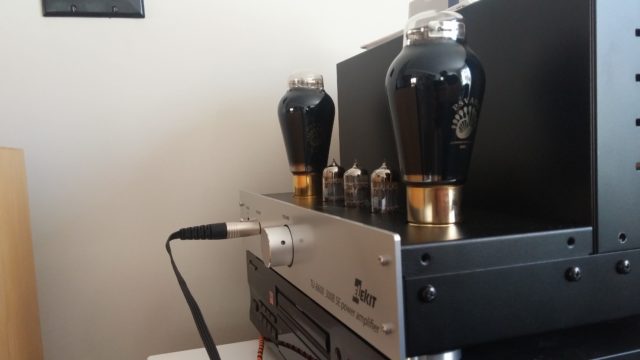
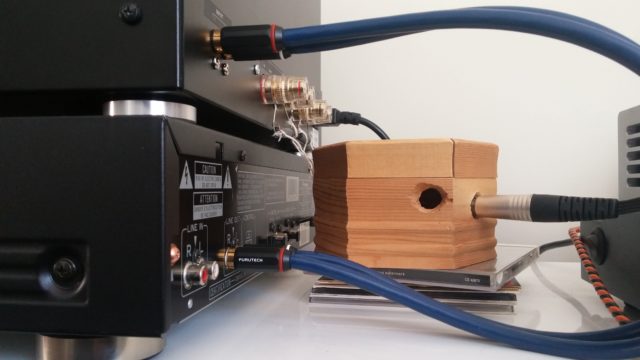 Now, I’m not a headphone reviewer or expert, so please take my comments with an extra grain of salt. Victor kindly loaned me his Audeze LCD3’s – these are better than any previous cans I’ve used (my references up to now were the Senn HD598 and the ATH-W1000). The headphone amp seems to be more than up the task. Critically, the circuit uses the output transformer, not an opamp. So essentially, you’re listening to the 300B tubes. In my past headphone experimenting, I found this to be a day-night difference. I even built a little box years back, so I could listen to my Audio-Technica’s with my single-ended tube amp. I kept the box around, though I rarely listen with headphones nowadays. So now, being the curious type, I decided to pit the Elekit headphone circuit against itself – by comparing the Elekit’s front jack with my homebuilt box, which uses 10 Ohm Mills resistors on the speaker taps. See the photos if I’m not making sense. Well, my resistor box uses less overall resistance, I think, so it was a little louder at the same gain setting. But after level matching, the sonic differences were negligible. If anything, I’d say the Ellie’s built in circuit sounded a little more refined. Again, I’ll repeat the caveat of my expertise in this area being limited, but I think it’s fair to say that the TU8600 includes a superb headphone amplifier. It may not keep up with a Woo Audio, or some of the other top-end dedicated headphone amps, but it is very good. There are also four headphone impedance adjustment settings – but these need to be done under the hood of the amp.
Now, I’m not a headphone reviewer or expert, so please take my comments with an extra grain of salt. Victor kindly loaned me his Audeze LCD3’s – these are better than any previous cans I’ve used (my references up to now were the Senn HD598 and the ATH-W1000). The headphone amp seems to be more than up the task. Critically, the circuit uses the output transformer, not an opamp. So essentially, you’re listening to the 300B tubes. In my past headphone experimenting, I found this to be a day-night difference. I even built a little box years back, so I could listen to my Audio-Technica’s with my single-ended tube amp. I kept the box around, though I rarely listen with headphones nowadays. So now, being the curious type, I decided to pit the Elekit headphone circuit against itself – by comparing the Elekit’s front jack with my homebuilt box, which uses 10 Ohm Mills resistors on the speaker taps. See the photos if I’m not making sense. Well, my resistor box uses less overall resistance, I think, so it was a little louder at the same gain setting. But after level matching, the sonic differences were negligible. If anything, I’d say the Ellie’s built in circuit sounded a little more refined. Again, I’ll repeat the caveat of my expertise in this area being limited, but I think it’s fair to say that the TU8600 includes a superb headphone amplifier. It may not keep up with a Woo Audio, or some of the other top-end dedicated headphone amps, but it is very good. There are also four headphone impedance adjustment settings – but these need to be done under the hood of the amp.

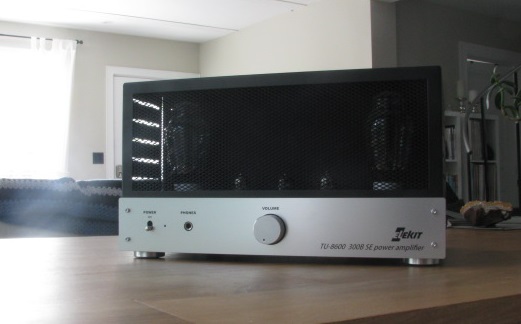

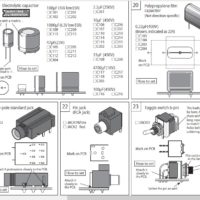
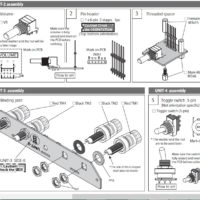
Been eagerly waiting for someone to review this amp. Any more circuit tidbits in part 2 planned?
Tim: the circuit/schematic is proprietary, as you might imagine, and is not being shared publicly.
Hi Noam.
I woke up in the morning to find this techie finally posted!
Thank you for your time and I’m looking forward to your review of the Lundahl transformers as well.
Please also try to compare it with the TU-8200, for us who are planning to switch.
I’d like to know what I’ll be gaining sound-wise, and what I’ll be losing by making a switch, since you mentioned that the amp doesn’t sound like a regular tube amp.
It still sounds like a tube amp – but not a budget tube amp. The distortion level seems very low, to me.
Hi all – how do I buy this amp in the UK? cheers
Hi Ben,
Good question. If there’s no UK distributor, EK Japan does have an order process:
http://www.elekit.co.jp/en/contact/orderflow.php
They also have a Facebook page, if you use FB that would allow you to communicate with an automatic translation.
https://www.facebook.com/EKJworld/
Noam
There is a Europe distributor in Poland I’m talking to now. http://getaudio.eu
Hi there
Many thanks for the detailed review of this amp.
I would be keen to know your thoughts on how this compares with the other 300B kit – the Audionote Kit 1
One of our reviewers owns both an AN Kit One and an Elekit 8230. He may be in a better position to comment.
The short answer is “it depends”. With the Lundahl trafos, the Elekit should give the AN a run for its money. In terms of cost, the AN is priced quite a bit higher nowadays. Check what opt you’re getting, before you order one.
Looking forward to Part Two!!
And with the Lundhal OPT, I wonder how it compares to a SE OTL. My TS SE OTL got water logged in an accident and is unrepairable. Looking at elekit now.
Hi Thomas,
I’m sorry to hear that! Unfortunately I’m not familiar with your amp so I couldn’t venture to say how it would compare.
Regards,
Noam
Hi,
Just want to say I agree with your comparison of the Psvane and Gold Lion 300B. For Psvane, mine is of the T II variant, thicker bass, but less articulated than the Gold Lions. You may also wish to try matching the Gold Lion 300B with JJ ECC802/3S gold pins. Mids are more forward and tighter bass.
Would be happy if there are suggestions on how to link this amp up with a subwoofer.
Will also try a Khozmo passive preamp soon which opens up the option of bi-amping.
Hi JZ
You can use a REL sub. They connect to the speaker out on the back of the (power) amp. They are very accurate and coherant with the main speakers due to having the same source rather than seperate sub out. I personally find other subs sound loose and boomy. They can also be connected like a regular sub.
Any thoughts on how this wold compare to a completely different amp – Rotel 1552 mk11? Sound quality, volume with the low power output of valve amps? etc?
(I havent used a valve amp before)
To use with Monitor Silver 100’s (and Rel sub)
Hi Dave,
If you haven’t tried a tube amp before I’d suggest borrowing one – or take your speakers someplace where you can try it out (friend, dealer). Your MA are lowish impedance and average sensitivity, which on paper isn’t a great match for a low-power triode amp like this one. Something like a push-pull EL34 amp would work better.
But, if there’s an Elekit for sale near you, check it out and let us know? You might love it.
Noam